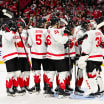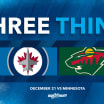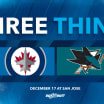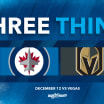As the Winnipeg Jets gear up for another set of back-to-back games, the preparation for this weekend's divisional match-ups against the Nashville Predators and St. Louis Blues began one week earlier - right in the middle of the Florida and Tampa Bay trip.
To understand why, we have to go back another week in the calendar - to March 4 and 5, specifically - to get a sense of what was happening in the offices of Video and Analytics Coach, Matt Prefontaine, and Coordinator of Hockey Video, James Cochrane.
"We typically watch the last three games of a team," said Prefontaine, who has been at the video controls for the Jets since the start of the 2014-15 campaign. "We start looking at their line-ups, we start looking at what they're doing through the different social media platforms and stuff, so we get an idea of what kind of lines they're running, who is injured, and what their team is going through."
FEATURE: A Second Set of Eyes
How Jets video coaches Matt Prefontaine and James Cochrane stay present, but also live one week ahead
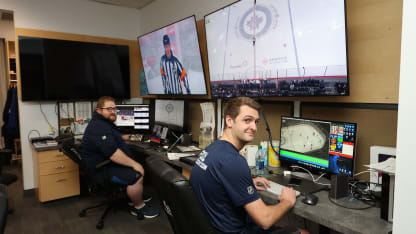
Cochrane, who joined the Jets in the 2017-18 season during an internship while at Brock University's sport management program, dives into the video as soon as it's available through an online platform.
For the Panthers and Lightning games, he compiles the last three games both teams played into what the team calls A, B, and C scouts.
"To go through a game would take an hour or so," Cochrane said. "Then I'll go through the clips after the fact, figuring out what we actually want to continue to use."
Neither Prefontaine or Cochrane had aspirations of being the go-to source for National Hockey League coaches' pre-scouts and video requests, but now that they're here, they wouldn't want it any other way.
--
Prefontaine, a product of Winnipeg, MB, actually wanted to go into microbiology. He was studying and working toward an undergrad in that very subject, but through some connections with the Manitoba Moose, he began working as an off-ice official.
Through that work, he learned some of the behind-the-scenes aspects of the professional game, and that interested him enough to head to Brock University, enrolling in the sport management program.
He found himself going down the communications track, helping to set up one of the first live streams of CIS hockey in the country. From there, he went off to the American Hockey League's Rockford IceHogs on an internship.
"I was their in-studio radio host, doing games, did colour commentary," Prefontaine recalled. "I got to know the coaches there and did some things for them. It just happened that at the end of the year, they had a video guy and they were looking for another video guy. My name got thrown out there and I got the job in Rockford."
He worked for the IceHogs for three seasons, from 2011 until the conclusion of the 2013-14 season as a video coach. His familiarity with new software put him on Tony Borgford's radar. Borgford was the Jets video coach, and in his final season, he reached out to Prefontaine about that new software.
"They had just transitioned to that software," Prefontaine said, and when Borgford left the Jets for an opportunity on the bench with Oklahoma City of the AHL, he put Prefontaine's name forward.
"I got a call, had an interview with Paul (Maurice) on the Friday and got the job later on Friday," said Prefontaine. "It happened pretty quickly."
Cochrane's ascent to the NHL level also happened at a rapid pace. Like Prefontaine, he's also a Brock alumnus, but he also didn't initially plan to get into hockey operations.
"I figured it was going to be somewhere on the business side of sport doing marketing or ticket sales," Cochrane said. "The summer before I came to the Jets, I interned with the Belleville Senators, sort of on the communications side, but doing a lot of things for them - from looking at mascot quotes to just setting up tents and talking to people about the new team coming to town. I sort of got my foot in the door there."
When the internship opportunity with the Jets popped up for 2017-18, Cochrane applied and was accepted.
"At first, it was kind of between the management side and the coaching side," Cochrane said. "It wasn't really specific. I was doing work for both, realizing some of the analytics side, the systems side, and the video side. I slowly transitioned over four or five years to the coaching side where I've been the last three years now, working under Matty."
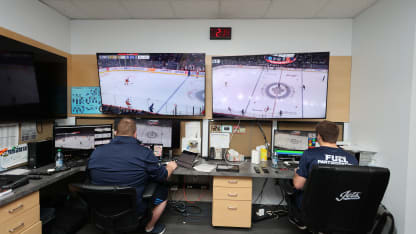
For the last two seasons, Cochrane has also been part of the full-season travelling party, meaning he and Prefontaine see a lot of each other.
It works out well, as they've been able to iron out a strong process that comes in handy when preparing for back-to-back scenarios.
As we know, that process begins a week in advance of any game on the calendar, but it's especially important with two games in rapid succession.
"For instance, one of the Florida games, we can pull it down (after the video gets put online), we can overlay data in it, and the game can be chopped up in the way we want it in two minutes," said Prefontaine. "Then we can push it out to all the coaches, which will give them the game at certain events - power play, special teams, face-offs, goals, shots, specific events we want to find - and then James can take a closer look and start breaking down more systematic stuff on that."
This advance work was what prepared the Jets for practice in Coral Springs, one day before they took on the Panthers, as one of the drills was aimed at how to get through Florida's neutral zone system.
Assistant coach Marty Johnston is the final presenter of the pre-scouts, but the work isn't done when the pre-scout is finished. Once the puck drops, Prefontaine and Cochrane are looking at numerous screens and taking in all sorts of data.
Prefontaine watches and marks (or, as they say, 'codes') how the team is performing in terms of systems play and scoring chances for and against. Cochrane is also looking at chances, but from a different scope.
"I'll label the chances with the type of chance they are and who is on the ice for them," said Cochrane. "So when the coaches come in, they can see a dashboard of how we were generating chances, how we were giving up chances, and how certain lines were doing chance wise - for and against - as well as individual players."
And all the data they compile can be seen by both of them. They also bring in work from the analytics team - Adam Konefal, Jordy Finnigan, and Evan Marantz - from back home in Winnipeg.
"We can ingest each other's data in. So as I'm coding the game on my side, I'm actually connected into James and what he's coding, so his data is coming into my computer," said Prefontaine. "The interesting thing about chances is everyone sees them potentially differently. We're on a pretty good wave length in terms of how we see them and how we define them as a team. But we still double check and make sure we have what we want."
Throughout the game, Prefontaine is on a headset talking with Johnston, and can also offer up-to-date stats on face-off percentages for late-game decisions if required, or offer insight into key line match-ups the Jets are watching.
When Mark Scheifele buried the overtime winner against the Panthers, that game was done on the ice.
Off of it, things are ramping up to be ready to go for Tampa Bay in less than 24 hours.

As the players filed off the ice after a big win, Cochrane is disassembling the game-day set-up so it can be packed with the rest of the gear on a truck. Meanwhile, as important as it is to pre-scout the opposition, it's equally important to evaluate Winnipeg's own performance. That's why Prefontaine is quickly downloading game video from the Panthers game and sending it to every coach's laptop.
"I'm synthesizing everything and bringing it all together. So the things I mark live during the game, bringing in our data sources, and pushing it to the coaches' computers," Prefontaine said. "The special teams coaches are probably going to look at the special teams stuff first, depending on what our goal is for the next day."
On top of that, Tampa Bay also played Saturday night, so that updated video is needed for the coaches to see.
"It has to be ready for the meeting the next day," said Cochrane. "So I'm cutting that right away."
The team piles onto the plane around 11:30 pm EST, and the coaches - armed with new video - get to work.
The Jets arrived at the team hotel around 1 am EST Sunday morning, and there was a power play meeting scheduled for 12 hours later.
"Brad (Lauer) would be going through the postgame from Florida and has all the stuff for Tampa already cut up, then he combines that into a meeting for Tampa that he likes," said Prefontaine. "Those guys are going to go through that."
And remember that neutral zone the Jets practiced in Florida? It just so happens that Tampa plays the same system.
"If we had a really good neutral zone regroup against Florida, we might use that against Tampa, which we did," Prefontaine said. "There is one with Mason Appleton where he swung around, made a chip in play, and broke their 1-1-3. So we used that clip in the pre-scout for Tampa."
When the game starts, the whole process begins again, just like the night before.
The power play meeting pays off, as the Jets score on the man advantage for the second straight game to take a 2-1 lead just 1:01 into the second. Then, when Morgan Barron's goal is challenged by Lightning head coach Jon Cooper, Prefontaine starts sending clips to the bench for the coaching staff to check out.
"When that goal happens, I'm looking at that immediately from the - in that case - overhead view," Prefontaine said. "I'm trying to see where Brenden Dillon was, how much contact was made, where the goalie was, and try to give them an idea of what I think. I'm trying to be as objective as possible. Right away I said I think they're going to challenge this one. I didn't think they were going to win it, but I thought they'd challenge it."
The call ends up going the Jets way, and proves to be the eventual game-winner. While that challenge was simple since it was the other bench calling it, Prefontaine said there are often times when both he and Cochrane need to work together.
On every entry - no matter the blue line - Prefontaine is checking to make sure it's onside. In that second or two, something could happen at the net, and that's when Cochrane has to be on his toes.
"I'm looking for high sticks and glove (passes) and that sort of stuff," said Cochrane. "That can come into play as well."
Each individual game situation dictates whether a challenge is necessary, and Prefontaine feels the Jets are at a really good spot when it comes to off-side challenges. Goaltender interference is sometimes more difficult.
"Not only if you think it's goalie interference, but should we challenge this for our goalie? What is the other team's power play like? How is our penalty kill doing? That could even be on a game level," Prefontaine said. "Say we've killed two or three in a row, or we've been really strong on our PK, and we've got them in a place we like them, maybe we take a challenge on it with more risk, depending on the time of game."
Cochrane chimes in.
"(Goaltending coach Wade Flaherty) will give input on those ones too."
Prefontaine says he hasn't kept his own individual or team record of coach's challenges won and lost, though he jokes that perhaps he should.
"We should keep a registry there from a negotiation standpoint," he laughed. "There are guys that know right away what their numbers are. I've never kept a record of it. I think there are a few websites that you can go and check on them. For the most part, I'd say we're pretty bang-on on offsides now. We don't challenge things that we don't have a pretty good feeling that we're going to win."
When the final buzzer goes, the process begins again. Cochrane starts taking things apart, Prefontaine downloads and sends off video, and the team is off to Carolina.
When the two wake up the next morning, they set their sights not only on Carolina - the site of the road trip finale - but also on Boston, who the Jets host later that week.
And it looks like a Nashville Predators game is now available for download. So the preparation for the next back-to-back is underway.

